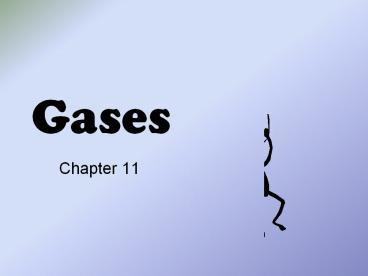Gases - PowerPoint PPT Presentation
1 / 13
Title:
Gases
Description:
Gases Chapter 11 Kinetic Theory and Gas Properties The kinetic theory assumes that Volume of gas particles is insignificant There is space between gas particles Gas ... – PowerPoint PPT presentation
Number of Views:88
Avg rating:3.0/5.0
Title: Gases
1
Gases
- Chapter 11
2
Kinetic Theory and Gas Properties
- The kinetic theory assumes that
- Volume of gas particles is insignificant
- There is space between gas particles
- Gas particles do not attract or repel each other
- Gas particles move rapidly and in constant random
motion
3
Variables that Describe a Gas
- Pressure (atm, mmHg, kPa)
- Volume (L)
- Temperature (C or K)
- Number of moles (mol)
4
What happens if you
- decrease the volume of the container?
- Pressure may increase
- Temperature may increase
- increase the temperature?
- Pressure may increase
- Volume may increase
- Increase the pressure?
- Temperature may increase
- Volume may decrease
5
Gas Laws
- Boyles
- P1 x V1 P2 x V2
- Charles
- V1 V2
- T1 T2
- Gay-Lussac
- P1 P2
- T1 T2
6
How do we tie it all together?
- P1V1 P2V2
- T1 T2
- AKA
- The Combined Gas Law
- Allows you to predict what will happen to a gas
if some of the conditions change!
7
Lets Practice!
- A gas with a volume of 4.0L at 90.0kPa expands
until the pressure drops to 20.0kPa. What is the
new volume if the temperature remains constant? - Identify what you know
- V14.0L
- P190.0kPa
- P220.0kPa
- T1T2
- Solve for what you dont know
- V2 P1V1 x T2
- T1 P2
- V2 18L
8
Now you try!
- A gas with a volume of 3.00x102mL at 150.0C is
heated until its volume is 6.00x102mL.What is the
new temperature of the gas if the pressure
remains constant at 1.0 atm during the heating. - T2 T1 x P2V2
- P1V1
- T2 300C
9
Ideal Gases vs. Real Gases
- Particles have no volume
- Particles are not attracted or repelled to each
other - Ideal gases can never be liquefied or solidified
- Particles have volume
- Particles experience intermolecular forces
- Real gases can be liquefied and solidified
10
Real Gases Act Like Ideal Gases
- When temperatures are very high and pressures are
very low - Can you explain why?
- High Temperatures means lots of kinetic energy so
particles are moving rapidly and randomly - Low Pressures means particles do not hit the
container (and each other) often, so they cannot
feel attraction and repulsion
11
The Ideal Gas Law
- Allows us to solve for a property of an ideal gas
when properties are constant! - PVnRT
- Ppressure Vvolume Ttemperature
- nnumber of moles
- R 8.31 L x kPa or 0.08206 L x atm
- K x mol K x mol
12
Lets Practice
- Determine the volume occupied by 0.582 mol of a
gas at 15C if the pressure is 81.1 kPa. - Identify what you know
- n0.582 mol
- T15C 273 288 K
- P81.1 kPa.
- R 8.31 L x kPa / K x mol
- V17 L
13
When to use the equations
- If the conditions of the gas change
- Then use the combined gas law
- If the conditions of the gas are fixed
- Then use the ideal gas law































